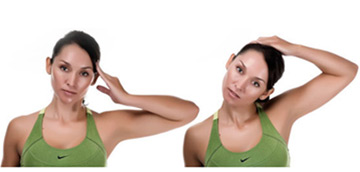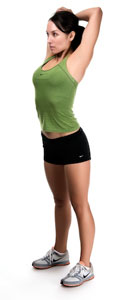

In this write-up I am discussing “how to fix nerd neck by doing neck tilts”.
The main idea behind this article by bestforwardheadposturefix.com is to raise the awareness levels of all the men, women and children out there who suffer from forward head posture, to learn, how to fix nerd neck naturally.
Ready to kick that pesky forward head posture to the curb?
Say hello to neck tilts—your new best friend in the battle against that ever-creeping slouch.
These simple yet powerful moves are about to become your go-to weapon for bringing your head back in line and relieving all that built-up neck tension.
As we dive deeper into this article, you’ll discover how these tilts not only help correct your posture but also leave you feeling like you’ve just had a mini spa day for your neck.
Let’s tilt our way to better posture, shall we?
Index of “How to Fix Nerd Neck by doing Neck Tilts” Article:
1) What is Neck-Tilt Exercise?
2) What is a Nerd Neck?
3) How to Perform Neck-Tilt Exercise Correctly?
4) How do Neck-Tilts Fix Nerd Neck?
5) FAQs on Nerd Neck on Neck Posture Correction
6) Takeaway
What is Neck-Tilt Exercise?
Let’s dive into the fascinating world of neck tilts! You might think, “It’s just a neck move, right?”
But hold on—there is more to it than meets the eye.
Neck tilts, a staple in the realm of physical therapy and wellness, have a rich history rooted in both ancient practices and modern science.
This exercise has been a part of human movement for centuries, dating back to yoga practices in ancient India.
The idea was simple: keep the neck mobile and aligned, an essential part of overall body balance.
Fast forward to the 20th century, and you will find that neck tilts became a go-to in physical therapy circles, particularly in addressing postural issues like forward head posture.
Scientific studies have backed up the importance of neck mobility. Incorrect neck posture restricts normal breathing that may cause health complications as time progresses.
Research from the Journal of Physical Therapy Science highlights how crucial neck tilts are in maintaining cervical spine health.
The cervical spine, the superhero of your neck, supports the head and ensures smooth communication between the brain and the rest of your body.
Keeping it in top shape is vital, and that is where neck tilts come into play.
So, the next time you think about neck tilts, remember—they are not just an exercise; they are a time-tested, scientifically supported method for keeping your neck in check!
What is a Nerd Neck?
Let’s talk about the “nerd neck” exercise—because, yes, even your neck can get a little too geeky for its own good!
So, what exactly is a nerd neck, you ask?
Imagine this: hours hunched over your computer, phone, or tablet, and voilà—you’ve got the classic “nerd neck,” also known as forward head posture.
It’s like your head is so eager to absorb all that screen time that it’s practically leading the way, leaving your poor neck and shoulders trailing behind.
Now, the nerd neck exercise swoops in like a hero to save the day! It is specifically designed to counteract that forward slump, helping to realign your head with your spine where it belongs.
Think of it as a way to remind your body that your head doesn’t need to be the first one through the door!
The exercise involves moves that strengthen the muscles in your neck, shoulders, and upper back, giving them the power to keep your head in check.
And no, it is not about turning you into some fitness guru; it is about reclaiming your posture, one nerdy move at a time.
So, get ready to nerd out on some serious neck-saving action!
How to Perform Neck-Tilt Exercise?
Ready to give your neck some much-needed love?
Let’s dive into how to perform the neck tilt exercise, step by step, and get that head back in the game!
Step 1: Find Your Posture
@ First things first—sit or stand tall. Imagine a string pulling you up from the top of your head.
@ Your shoulders should be relaxed, and your spine straight.
@ You are not slouching. You are owning your space!
Step 2: The Tilt
@ Now, gently tilt your head to one side, as if you’re trying to touch your ear to your shoulder—but don’t actually move your shoulder.
@ Keep it chill and relaxed. Feel that sweet stretch along the opposite side of your neck? That’s the magic happening!
Step 3: Hold It Right There
@ Hold the tilt for about 15 to 30 seconds.
@ Breathe deeply—no rushing! This is your moment to unwind and stretch out that tension.
Step 4: Return and Repeat
@ Slowly bring your head back to the center.
@ Now, do the same tilt on the other side.
@ Hold, breathe, and enjoy the stretch.
Step 5: Repeat
@ Repeat this 3-5 times on each side, and you’re golden!
@ And there you have it!
@ A quick, easy neck tilt routine to keep your posture on point and your neck feeling fabulous!
How do Neck-Tilts Fix Nerd Neck?
Neck tilts are more than just a simple stretch; they are a targeted approach to correcting that notorious forward head posture, commonly known as “nerd neck.”
Let us break down how this exercise works its magic:
Realigning the Cervical Spine
Nerd neck happens when your head consistently juts forward, placing extra strain on the cervical spine.
This forward posture causes the neck muscles—particularly the sternocleidomastoid and upper trapezius—to tighten and shorten over time.
Neck tilts directly address this by encouraging these muscles to lengthen and relax.
When you tilt your head from side to side, you’re gently pulling these muscles back into their natural position, which helps to realign your cervical spine.
A study published in the Journal of Physical Therapy Science highlights that regular stretching exercises, including neck tilts, are effective in improving cervical spine alignment and reducing forward head posture.
Strengthening Key Muscles
Beyond stretching, neck tilts also help strengthen the muscles that are responsible for holding your head upright.
When these muscles are weak, your head is more likely to drift forward into that nerd neck position.
By consistently performing neck tilts, you’re gradually building up the strength in these muscles, enabling them to support your head properly. This is quite similar to chin-tucks.
Research from the Journal of Orthopaedic & Sports Physical Therapy found that exercises targeting the deep neck flexors and upper back muscles—like neck tilts—can significantly improve postural control and reduce the forward head posture.
Promoting Long-Term Posture Correction
The key to fixing nerd neck is not just a one-time fix; it’s about creating a habit.
By incorporating neck tilts into your daily routine, you’re training your body to maintain proper posture over time.
This regular practice helps to prevent the recurrence of forward head posture and promotes long-term neck health.
In summary, neck tilts are a powerful tool in combating nerd neck.
They work by realigning the cervical spine, strengthening essential muscles, and promoting consistent, healthy posture, all backed by scientific evidence.
FAQs on Nerd Neck on Neck Posture Correction
Q1: How do neck tilts help in correcting forward head posture?
A1: Neck tilts stretch and strengthen the muscles along the sides of the neck, which can alleviate tension and promote better alignment. Regular practice of neck tilts can help counteract the forward head posture by improving flexibility and muscle balance.
Q2: What is the correct technique for performing neck tilts to address forward head posture?
A2: To perform neck tilts:
- Sit or stand upright with your back straight.
- Gently tilt your head to the right, bringing your ear toward your right shoulder.
- Hold the position for a few seconds, feeling a stretch along the left side of your neck.
- Return to the starting position.
- Repeat on the left side.
Performing this exercise 3–5 times on each side can help improve neck flexibility and posture.
Q3: How often should neck tilts be performed to see improvements in forward head posture?
A3: Incorporating neck tilts into your daily routine, performing them 3–5 times on each side, can lead to noticeable improvements over time. Consistency is key to effectively correcting forward head posture.
Q4: Are there any precautions to consider when doing neck tilts for forward head posture?
A4: While neck tilts are generally safe, it is important to perform them gently to avoid overstretching. If you experience pain or discomfort, stop the exercise and consult a healthcare professional.
Q5: Can neck tilts be combined with other exercises to enhance the correction of forward head posture?
A5: Yes, combining neck tilts with exercises that strengthen the upper back and shoulders, such as shoulder blade squeezes and chest stretches, can provide a more comprehensive approach to correcting forward head posture.
Takeaway
Neck tilts are like your neck’s personal trainer, working diligently to correct that bad posture that’s been creeping up on you.
When your head starts inching forward—whether it’s from hunching over your laptop or scrolling on your phone—neck tilts come to the rescue by gently coaxing your head back into alignment with your spine.
These tilts aren’t just about temporary relief; they’re about retraining your muscles for long-term benefits.
Just remember to conduct a plumb line test to check your posture at home.
By regularly performing neck tilts, you are stretching and strengthening the key muscles in your neck and upper back, like the sternocleidomastoid and upper trapezius.
you might want to club this exercise with rows or scalene stretch to double the impact.
This targeted exercise helps counteract the shortening and tightening of these muscles that contribute to forward head posture.
A study in the Journal of Physical Therapy Science supports this, showing that consistent stretching exercises, including neck tilts, significantly improve cervical alignment and reduce the forward head posture.
In essence, neck tilts don’t just offer a quick fix; they provide a lasting solution.
By integrating them into your daily routine, you’re actively reversing bad neck posture, ensuring your head stays properly aligned, and promoting overall neck health.
It is a simple yet scientifically-backed way to keep your posture in check!
References:


